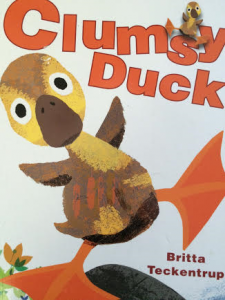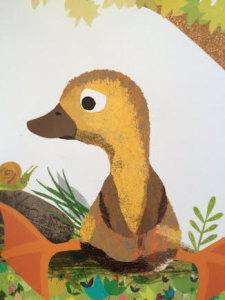Author: Britta Teckentrup
Illustrator: Britta Teckentrup
Publishing Information: Boxer Books Limited, 2013
Number of Pages: 20
Genre: Fable


Analysis:
Clumsy Duck is a small duck who has big feet, which causes her to fall quite a bit and bump into things. Her friend, Chick, tries to do different activities with Clumsy Duck in order to see just how clumsy she is, and if there are any activities she can do without being so clumsy. In the end, Chick and Clumsy Duck discover that Clumsy Duck’s big feet are perfect for swimming very gracefully in the water.
The story starts with Clumsy Duck feeling bad about herself, because she thinks she has a flaw (her feet) that prevents her from doing things that everyone else can. However, she finds in the end that this very thing she initially viewed as a flaw was actually one of her best strengths when she used it in a different context. This can serve as both a window and a mirror for children, as it teaches them that being different can work to their advantage, and they should not feel bad about the parts of them that are different. Furthermore, the story highlights the ways in which Chick assures her friend that they will find something she is good at and tries different activities to figure out what that is. This provides a door for children to apply the same practices with their peers, rather than treating their differences in a negative way. This book definitely reflects a theme of friendship and self-acceptance that can help kids with their self-perception.
The illustrations have bright colors that help to show the hopefulness that is seen throughout the process of finding Clumsy Duck’s best use for her big feet. Also, the illustrations are not framed, allowing the reader to experience the story with the characters. I thought it was also encouraging that both Clumsy Duck and Chick were always the same size as one another throughout the story, which shows readers that they are equals (despite Clumsy Duck’s differences). Finally, I found it interesting that, for most of the story, Clumsy Duck is on the right side of the page, as this indicates the conflict she is facing within herself throughout the story.
I had the phrase “If at first you don’t succeed, try, try again” as a mantra in my head as a reflected on the storyline, because of Chick’s persistence to find something her friend would do well. This can also help children to not be discouraged by their shortcomings, and to pick themselves up and move forward. Due to the ideologies of self-acceptance, acceptance of others, and friendship that were embedded in the story, I thought this book was a very cute way to present valuable life-lessons for young children.
